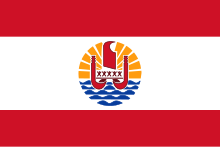Portal:Oceania
Appearance
Portal maintenance status: (June 2018)
|
The Oceania PortalOceania (UK: /ˌoʊsiˈɑːniə, ˌoʊʃi-, -ˈeɪn-/ OH-s(h)ee-AH-nee-ə, -AY-, US: /ˌoʊʃiˈæniə, -ˈɑːn-/ ⓘ OH-shee-A(H)N-ee-ə) is a geographical region including Australasia, Melanesia, Micronesia, and Polynesia. Outside of the English-speaking world, Oceania is generally considered a continent, while Mainland Australia is regarded as its continental landmass. Spanning the Eastern and Western hemispheres, at the centre of the water hemisphere, Oceania is estimated to have a land area of about 9,000,000 square kilometres (3,500,000 sq mi) and a population of around 44.4 million as of 2022. Oceania is the smallest continent in land area and the second-least populated after Antarctica. Oceania has a diverse mix of economies from the highly developed and globally competitive financial markets of Australia, French Polynesia, Hawaii, New Caledonia, and New Zealand, which rank high in quality of life and Human Development Index, to the much less developed economies of Kiribati, Papua New Guinea, Tuvalu, Vanuatu, and Western New Guinea. The largest and most populous country in Oceania is Australia, and the largest city is Sydney. Puncak Jaya in Indonesia is the highest peak in Oceania at 4,884 m (16,024 ft). The rock art of Aboriginal Australians is the longest continuously practiced artistic tradition in the world. Most Oceanian countries are parliamentary democracies, with tourism serving as a large source of income for the Pacific island nations. (Full article...) Selected geographic article - show another French Polynesia (/ˌpɒlɪˈniːʒə/ ⓘ POL-ih-NEE-zhə; French: Polynésie française [pɔlinezi fʁɑ̃sɛːz] ⓘ; Tahitian: Pōrīnetia Farāni) is an overseas collectivity of France and its sole overseas country. It comprises 121 geographically dispersed islands and atolls stretching over more than 2,000 kilometres (1,200 mi) in the South Pacific Ocean. The total land area of French Polynesia is 3,521 square kilometres (1,359 sq mi), with a population of 278,786 (Aug. 2022 census) of which at least 205,000 live in the Society Islands and the remaining population lives in the rest of the archipelago. French Polynesia is divided into five groups of islands:
Related portalsSelected article - show another Moai or moʻai (/ˈmoʊ.aɪ/ ⓘ MOH-eye; Spanish: moái; Rapa Nui: moʻai, lit. 'statue') are monolithic human figures carved by the Rapa Nui people on Rapa Nui (Easter Island) in eastern Polynesia between the years 1250 and 1500. Nearly half are still at Rano Raraku, the main moai quarry, but hundreds were transported from there and set on stone platforms called ahu around the island's perimeter. Almost all moai have overly large heads, which account for three-eighths of the size of the whole statue. They also have no legs. The moai are chiefly the living faces (aringa ora) of deified ancestors (aringa ora ata tepuna). The statues still gazed inland across their clan lands when Europeans first visited the island in 1722, but all of them had fallen by the latter part of the 19th century. The moai were toppled in the late 18th and early 19th centuries, possibly as a result of European contact or internecine tribal wars. (Full article...) Did you know - load new batch
General images - load new batchThe following are images from various Oceania-related articles on Wikipedia.
Topics
SubcategoriesThings you can doAssociated WikimediaThe following Wikimedia Foundation sister projects provide more on this subject:
In other languagesWikipedia in other languages used in Oceania:
More portals | ||||||||||||||